Excerpts from Jim Conrad's
Naturalist Newsletter
entry from field notes dated January 20, 2023, taken in scrub ~1.5km south of Camargo, elevation ±1,700m (7280 ft); bedrock of fine-grained, calcareous mudrock; Querétaro state, MÉXICO, (N21.09°, W99.73°)
SOLDIERBUSH
 The lanky bush at the right grew atop a rocky ridge in thin soil, during the dry season after which the rainy season never developed as it should have. It's inspiring to see how it manages to flower so robustly. However, most of its stem below the flowering part remains leafless, plus a second stem just to the right of the main stem bears no greenness at all.
The lanky bush at the right grew atop a rocky ridge in thin soil, during the dry season after which the rainy season never developed as it should have. It's inspiring to see how it manages to flower so robustly. However, most of its stem below the flowering part remains leafless, plus a second stem just to the right of the main stem bears no greenness at all.
This is one of those plants about which it's hard to say whether it's herbaceous or woody. In botany the word for plants that are woody at the base but remaining herbaceous above is suffruticose, and this is definitely a suffruticose species.
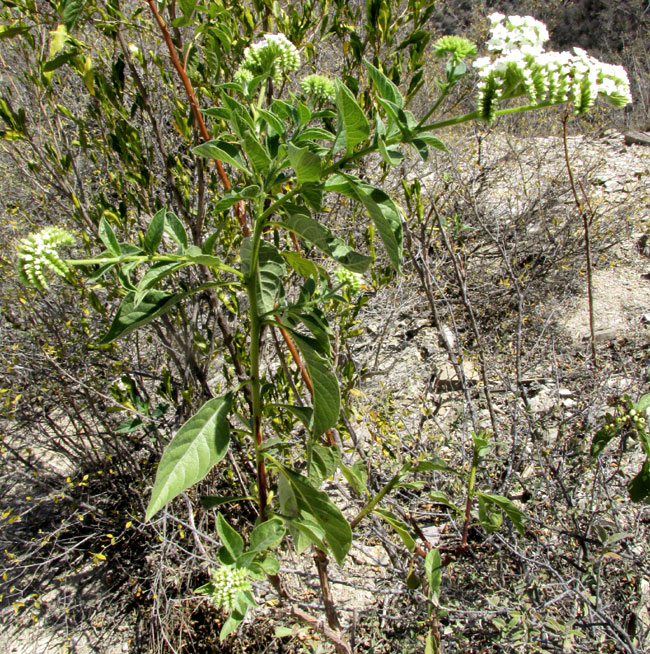
Leaves appear singly at each stem node, and are simple with slender petioles. Clusters of flowers grow at branch tips.
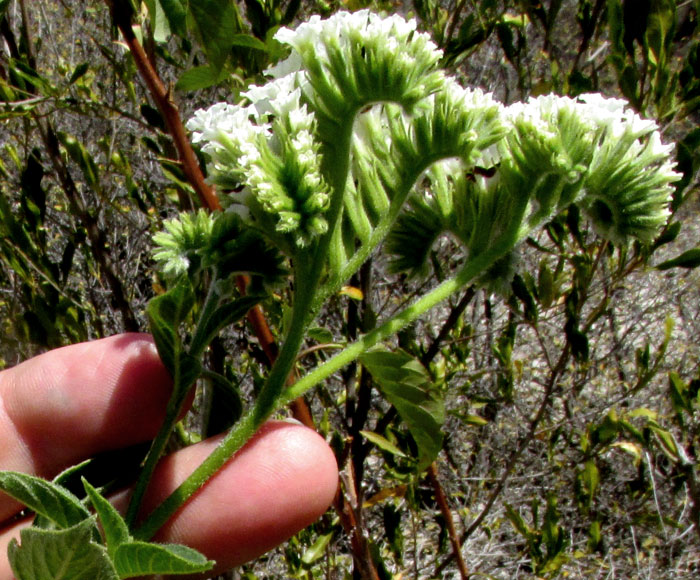
The flowering heads, or inflorescences, are of a special kind termed helicoid cymes. The definition of a helicoid cyme is so complex that it's easier just to imprint the above on your mind as a good example. The term helicoid is based on the word helix, like a corkscrew or spiral staircase. Forget-me-not species often display inflorescences like this. They're in the Borage Family, the Boraginaceae, and that's the family I think of first when seeing such inflorescences.
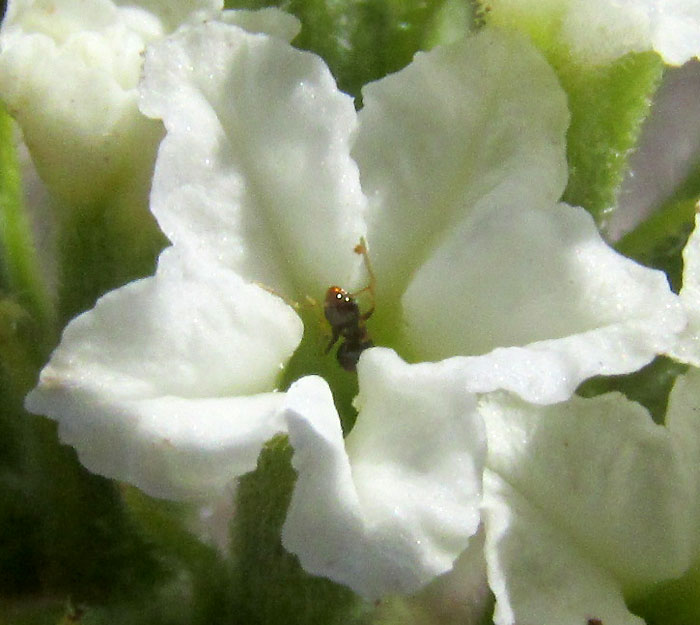
The above radially symmetrical corolla with five lobes abruptly forming a slender tube at their bases, and stamens so deep in the tube you can't see them, are common features of the Borage Family.
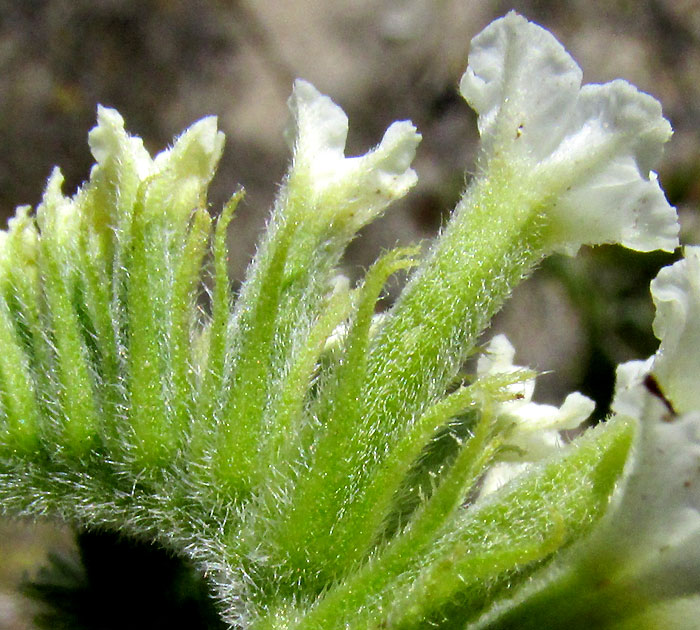
The white corollas become green and hairy below their lobes, like the long, slender calyx lobes.
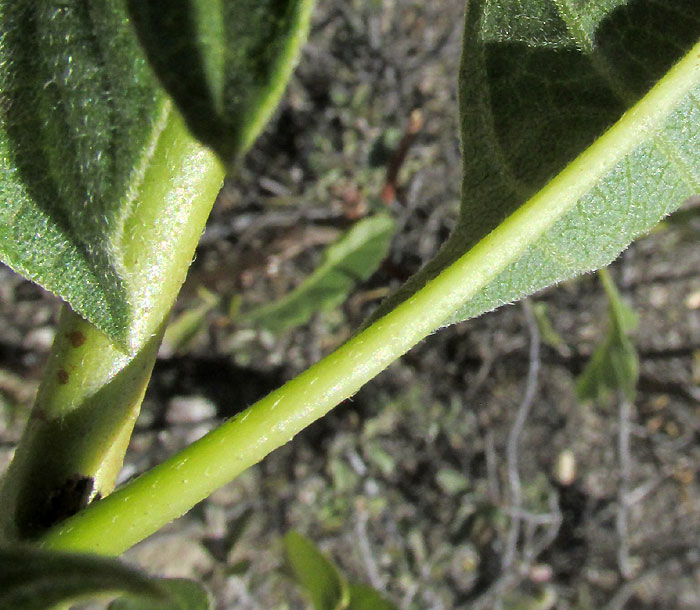
The stems and petioles are only slightly hairy, but leaf tops -- one shown above in the top, right corner -- are densely so.
Fairly convinced we had a Borage Family member, the next question was which genus to look into. On sandy beaches back in the Yucatan often we met a shrub with inflorescences and flowers much like what's seen above, on the Sea-Lavender, Tournefortia gnaphalodes. That bush's genus Tournefortia is a big one, embracing maybe about 150 mostly tropical and subtropical species worldwide, with about 30 occurring in Mexico, so that was a good place to start.
In our upland region of central Mexico called the Bajío, if you have a shrub whose branches don't elongate and crawl along the ground, the inflorescences are clustered closely together, and the corollas with their tubes are over 5mm long (0.2inch), you have TOURNEFORTIA MUTABILIS. Pictures on the Internet nicely match our plant.
Tournefortia mutabilis occurs not only in dry, scrubby areas like our ridgetop bush, but also it gets into disturbed areas including abandoned fields, oak forests and tropical deciduous forests in general, up to about 1900m (6250ft). In some areas it's abundant. The species is distributed from northern Mexico south into Nicaragua. The GBIF distribution map for the species also shows a cluster of the species in the islands north of Australia, so possibly it's invasive there.
Species of Tournefortia often are known as soldierbushes. Tournefortia mutabilis has no English name of its own, though there are plenty of Spanish and native American ones, maybe the most commonly used in Mexico being cola de alacrán, meaning "scorpion tail," but that name is used for numerous species producing helicoid inflorescences.
A. Sharma and others in their 2017 study entitled "Antibacterial activities of medicinal plants used in Mexican traditional medicine" report that compounds in Tournefortia mutabilis have shown antimicrobial properties. Roberto Esquivel-García and others, in a 2018 work entitled "Ethnomedicinal plants used for the treatment of dermatological affections on the Purépecha Plateau, Michoacán, Mexico" say that decoctions of our plant's aerial parts are used by central Mexico's Purépecha native people to treat superficial skin infections.